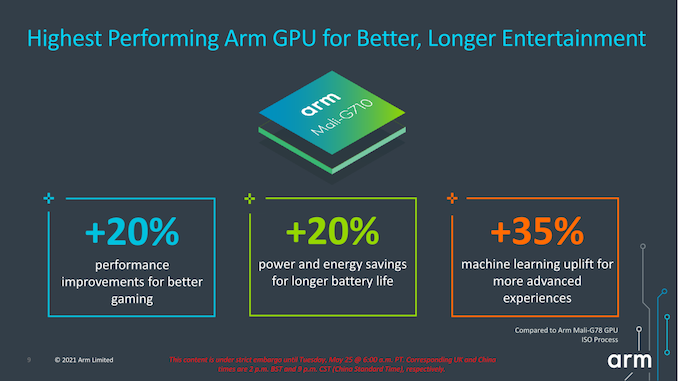Arm Announces New Mali-G710, G610, G510 & G310 Mobile GPU Families
by Andrei Frumusanu on May 25, 2021 10:00 AM EST
Alongside with today’s extremely large and comprehensive CPU line-up announcement including the new Cortex-X2, Cortex-A710, Cortex-A510, new DSU-110 and new interconnects, we’re seeing the announcement of Arm’s newest Mali GPU line-up. Similar to the CPU family, we’re also seeing an extensive line-up announcement with the new Mali-G710 flagship series, the G510 middle-range, and the new ultra-area efficient Mali-G310.
The new GPU series follows up in the same Valhall GPU family that was started back in 2019 with the Mali-G77 and seen minor improvements with the Mali-G78 in last year’s announcements and seen silicon adoption in this year’s SoC’s such as the Kirin 9000, Exynos 2100 or the new MediaTek Dimensity SoCs.
At the high-end, the Mali-G710 is a direct successor to the Mali-G78 and is a relatively straightforward generational improvement in terms of what it’s aiming for: the highest possible performance that Arm’s architects can achieve in a Mali GPU. The Mali-G610 is a branding exercise that differentiates the same microarchitecture as the G710 at lower core counts, aiming to aid partners to better differentiate flagship products from the “premium” segment.
The Mali-G510 is a successor to the 2019 Mali-G57 and is a major upgrade to Arm’s mid-range portfolio, bringing extremely large generational performance boosts as well as power efficiency gains over the predecessor.
Finally, the new Mali-G310 is a new Valhall based low-end entry that represents a multi-generation architectural bump over the old-in-the-tooth Bifrost based Mali-G31 and targets the low-end area-efficiency focused market where we see hundred of billions of low-cost devices and other embedded markets such as smart TVs.
As gross overview, the highlight today for most readers will be focused around the new Mali-G710 flagship GPU. The improvements that the company is promising is roughly a +20% boost in performance in a ISO-process node GPU configuration compared to a comparable Mali-G78 GPU. Similarly, at similar performance, the new GPU design promises a -20% reduction in power consumption and thus also energy efficiency gain.
Recently, Arm has also made a focus on Machine Learning on the GPU and here the new design is promising a larger +35% boost in performance.












30 Comments
View All Comments
ForNein - Tuesday, May 25, 2021 - link
Which Mali gpu is Google's Whitechapel going to have? I suspect it will be something older and unimpressive.EthiaW - Tuesday, May 25, 2021 - link
Google has floudered in its every hardware project, don't hold expectation in them friend.Kangal - Thursday, May 27, 2021 - link
They're somewhat incompetent in software too. Heaps of easy and obvious bugs in every platform in every update... at least when compared to their competitors. Also their biggest successes were projects that was kickstarted externally, and simply acquired.Do they have poor QA Department or something?
Or maybe it's just they have some of the worst management team in the world, where they release half-finished projects to the world, only to double-back and kill them off in a small timeframe.
Spunjji - Friday, May 28, 2021 - link
Their internal structure rewards doing novel things, not sustained success.Fulljack - Wednesday, May 26, 2021 - link
probably last year's G78, but it's also possible to use this new G710.tuxRoller - Thursday, May 27, 2021 - link
According to xda (https://www.xda-developers.com/google-pixel-6-same... it looks to be G78.SarahKerrigan - Tuesday, May 25, 2021 - link
"The only other surviving GPU IP vendor"This is not accurate. Think Silicon is one exception; Verisilicon, which inherited the Vivante product family, is arguably another, though it hasn't seen much movement since the GC8k came out.
Infy2 - Tuesday, May 25, 2021 - link
No ray tracing support? Boo!Wereweeb - Wednesday, May 26, 2021 - link
If you want a frying pan functionality, just ask.Spunjji - Friday, May 28, 2021 - link
ARM have a primary focus on area efficiency, spending area on RT features that are too slow to use would not be a good decision for them.